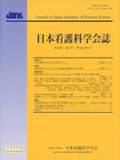Japanese
English
- 販売していません
- Abstract 文献概要
- 参考文献 Reference
- サイト内被引用 Cited by
要旨
目的:高齢者訪問看護の質指標(16領域483指標)開発の一部として,全国の訪問看護ステーションで働く看護師を対象に,指標に関する実践の自己評価や指標についての意見を調査した.
方法:全国5,322カ所の訪問看護ステーションに10,644通の調査票を郵送し回答を得た.
結果:回答は3,068通(29.7%)あった.全領域で平均7割程度の指標が実施していると回答されていた.指標への「はい(=実施している)」という回答率は摂食・嚥下障害ケアや口腔ケアが低く,清潔ケア等が比較的高かった.情報収集,精神的支援,医師への報告など侵襲が少なく病棟でも一般的なケアは「はい」の回答率が高く,判断を伴うアセスメント,学習を要する特殊な技術の提供やケア実施後の評価は「はい」の回答率が低かった.全領域で「訪問看護で必要な項目が網羅されている」という意見が7割以上得られた.
結論:開発中の訪問看護質指標では,指標ごと,領域ごとに実施率にある程度のばらつきがみられた.今回の結果を参考にしつつ質指標の開発を進めていきたい.
Abstract
Purpose:The purpose of this study was to examine the results of a national self-evaluation survey of nurses working at home care nursing stations using 483 quality indicators (QIs) covering 16 domains of home healthcare nursing. We have developed these QIs for quality assurance of home care nursing for older adults in Japan.
Method:We sent 10,644 questionnaires to nurses working at 5,322 home care nursing stations in Japan. In this survey we asked the nurses to evaluate their daily practices based on the QIs and to provide suggestions for improving the QIs.
Results:Altogether 3,068(29.7%) nurses responded. The response showed that on average over 70% of QIs from all 16 areas were considered to be practiced in the nurses’daily work. The QIs in the areas of “assisting eating/dysphasia”and “oral hygiene”showed low practice rates, while the QIs in “assisting bathing/cleansing”showed high practice rates. The QIs with high practice rates were mainly related to information gathering, emotional support, or reporting to the physician. They required minimum physical/emotional invasion and were common in hospital nursing. The QIs with the following characteristics tended to show low practice rates: assessments that require high-level judgment, interventions with skills that require specialized learning, or evaluation of provided care. In all areas, over 70% of nurses were affirmative of the QIs stating that the QIs covered major aspects of home care nursing for older adults.
Conclusion:It was found that there was a certain variety in the practice rate in these QIs.We would like to continue our efforts to develop QIs for home care nursing for older adults in Japan.
Copyright © 2008, Japan Academy of Nursing Science. All rights reserved.


